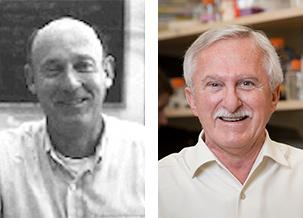
Duke missed the Nobel Prize this year, but we can at least claim a share of the reflected glory.
George P. Smith, one of three winners of the 2018 Nobel Prize for Chemistry, did some of the early work for his award-winning research at Duke University.
Smith, now a distinguished professor emeritus of biological sciences at the University of Missouri, developed a technology known as ‘phage display’ that allows scientists to better study interactions between proteins, peptides, and DNA.
The technique involves using bacteriophages—viruses that infect bacteria—to connect proteins with the genetic information that encodes them. The discovery has since been applied to developing antibody therapies for treatment of cancer, rheumatoid arthritis and multiple sclerosis.
Prior to publishing his phage display paper in the journal Science in 1985, Smith went on sabbatical from the University of Missouri in 1983-1984 and came to work at Duke University with Robert Webster, professor emeritus of biochemistry.
“Much of this work was performed at Duke University in the laboratory of R.E. Webster, whom I thank for supporting this work and supplying the environment in which it was carried out,” states Smith in the acknowledgement section of the paper. “I am also grateful to P. Modrich for purified Eco RI protein, pan4, and Eco RI antiserium and to C. Kerner for technical assistance.”
That ‘P. Modrich’ would be Duke Nobel Laureate Paul Modrich, the James B. Duke Professor of Biochemistry, who said his lab only supplied some reagents to the research.
“George spent about two years on sabbatical in my lab,” said Webster. “During this time, he demonstrated that he could have a chimeric protein of EcoR1 endonuclease fused to the pIII proteins be packaged into phase particles. He immediately recognized the power of this and advanced the technique over the years.”
The technique was later used by fellow 2018 Nobel Prize Award for Chemistry recipient Sir Gregory P. Winter of the University of Cambridge to develop antibodies that could be used to target particular cells, leading to the development of new drugs to treat cancer and autoimmune conditions.
“George is a forward-thinking scientist and is very deserving of the prize,” said Webster. “It was nice to have had him start this work in my lab.”
This year’s third winner in Chemistry, Frances H. Arnold, the Linus Pauling Professor Chemical Engineering at the California Institute of Technology, won for her work directing the evolution of enzymes which has led to the development of biofuels and new pharmaceutical drugs.